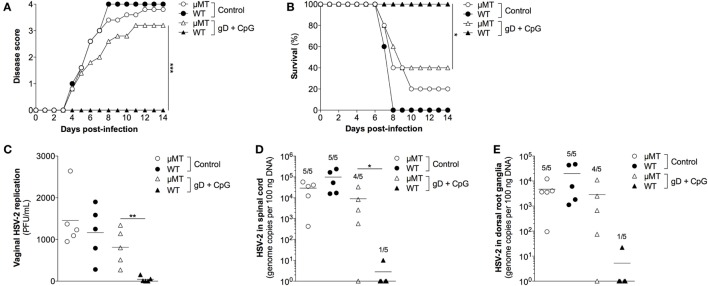Figure 4.
The protective immunity conferred by nasal immunization is critically dependent on functional B cells. Female μMT and wild-type C57BL/6 mice were immunized with gD together with CpG three times, with 1 week interval. Four weeks later, the immunized mice along with a PBS-treated control groups were given progesterone, followed 6 days later by a vaginal challenge with a lethal dose of HSV-2. (A) Disease progression after HSV-2 challenge (n = 5). Symptoms of the disease were scored as 0 = healthy, 1 = genital erythema, 2 = moderate genital inflammation, 3 = severe genital lesions, and 4 = hind limb paralysis for 14 days after challenge. (B) Survival rate after the viral challenge over a period of 14 days (n = 5). (C) HSV-2 levels in the vagina at day 3 after challenge, displayed as plaque forming units per mL (n = 5). (D,E) Spinal cord and DRG were collected at the time of sacrifice and tested for the presence of HSV-2 DNA (n = 5). Results displayed as genome copies per 100 ng sample DNA. The numbers shown above the bars represent the number of positive samples. Data points in (C–E) represent individual mice and the lines indicate the mean value of each group. Statistical significance for the end points in (A) and between the groups in (C–E) was calculated with a two-tailed unpaired t test and 95% CI. Survival (B) was analyzed by the Kaplan–Meier method and the Log-rank test. Differences were considered statistically significant at p values of <0.05 (*), <0.01 (**), and <0.001 (***).

